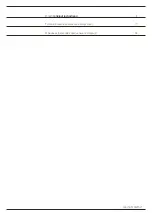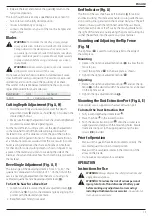
12
English
Lower Blade Guard
WARNING: The lower blade guard is a safety feature
which reduces the risk of serious personal injury.
Never use the saw if the lower blade guard is
missing, damaged, misassembled or not working
properly. Do not rely on the lower blade guard to
protect you under all circumstances. Your safety
depends on following all warnings and precautions
as well as proper operation of the saw. Check lower
blade guard for proper closing before each use as
outlined in
Further safety instructions for All saws
.
If the lower blade guard is missing or not working
properly, have the saw serviced before using.
To assure product safety and reliability, repair,
maintenance and adjustment should be performed
by an authorized service center or other qualified
service organization, always using identical
replacement parts.
Checking the Lower Guard (Fig. A)
1. Turn tool off and disconnect from power supply.
2. Rotate the lower blade guard retracting lever
6
from the
fully closed position to the fully open position.
5. Depress the blade lock button
21
while turning the saw
spindle with the hex key
14
until the blade lock engages
and the blade stops rotating.
6. Tighten the blade clamping screw firmly with the
blade wrench.
nOTE:
Never engage the blade lock while saw is running, or
engage in an effort to stop the tool. Never turn the saw on
while the blade lock is engaged. Serious damage to your saw
will result.
To Replace the Blade (Fig. A, C)
WARNING:
Remove battery before service, adjustment,
installing or removing accessories.
1. To loosen the blade clamping screw
8
, depress the blade
lock button
21
and turn the saw spindle with the hex
key
14
until the blade lock engages and the blade stops
rotating. With the blade lock engaged, turn the blade
clamping screw clockwise with the hex key (screw has
left‑hand threads and must be turned clockwise to loosen).
2. Remove the blade clamping screw
8
and outer clamp
washer
19
only. Remove old blade.
3. Clean any sawdust that may have accumulated in the
guard or clamp washer area and check the condition and
operation of the lower blade guard as previously outlined.
Do not lubricate this area.
4. Select the proper blade for the application (see
Blades
).
Always use blades that are the correct size (diameter)
with the proper size and shape center hole for mounting
on the saw spindle. Always assure that the maximum
recommended speed (rpm) on the saw blade meets or
exceeds the speed (rpm) of the saw.
5. Follow steps 2 through 6 under
To Install the Blade
, making
sure that the blade will rotate in the proper direction.
Changing Blades
To Install the Blade (Fig. A, C)
WARNING:
Remove battery before service, adjustment,
installing or removing accessories.
1. Place inner clamp washer
20
on saw spindle
17
properly.
2. Retract the lower blade guard
7
and place blade on saw
spindle against the inner clamp washer, making sure that
the blade will rotate in the proper direction (the direction
of the rotation arrow on the saw blade and the teeth must
point in the same direction as the direction of rotation arrow
on the lower blade guard). Do not assume that the printing
on the blade will always be facing you when properly
installed. When retracting the lower blade guard to install
the blade, check the condition and operation of the lower
blade guard to assure that it is working properly. Make sure
it moves freely and does not touch the blade or any other
part, in all angles and depths of cut.
3. Place outer clamp washer
19
on saw spindle with the large
flat surface against the blade with beveled side facing out.
4. Thread blade clamping screw
8
into saw spindle by
hand (screw has left‑hand threads and must be turned
counterclockwise to tighten).
Inserting and Removing the Battery Pack
from the Tool (Fig. J)
nOTE:
Make sure your battery pack
3
is fully charged.
To Install the Battery Pack into the Tool Handle
1. Align the battery pack
3
with the rails inside the tool’s
handle (Fig. J).
2. Slide it into the handle until the battery pack is firmly seated
in the tool and ensure that you hear the lock snap into place.
To Remove the Battery Pack from the Tool
1. Press the release button
13
and firmly pull the battery pack
out of the tool handle.
2. Insert battery pack into the charger as described in the
charger section of this manual.
Fuel Gauge Battery Packs (Fig. B)
Some
D
e
WALT
battery packs include a fuel gauge which
consists of three green LED lights that indicate the level of
charge remaining in the battery pack.
To actuate the fuel gauge, press and hold the fuel gauge
button
27
. A combination of the three green LED lights will
illuminate designating the level of charge left. When the level
of charge in the battery is below the usable limit, the fuel gauge
will not illuminate and the battery will need to be recharged.
nOTE:
The fuel gauge is only an indication of the charge left on
the battery pack. It does not indicate tool functionality and is
subject to variation based on product components, temperature
and end‑user application.
WARNING:
Use only
D
e
WALT
battery packs and chargers.
Содержание XR DCS512
Страница 1: ...DCS512 ...
Страница 3: ...1 Fig A Fig B 12 13 5 9 10 11 7 8 15 6 2 3 4 1 14 13 3 3 13 16 XXXX XX XX 27 ...
Страница 4: ...2 19 8 15 17 21 20 23 12 22 18 5 22 24 24 Fig C Fig E Fig G Fig D Fig F Fig H ...
Страница 5: ...3 5 10 25 26 12 Fig I Fig K Fig M Fig L Fig N Fig J ...
Страница 55: ...53 Українська ...
Страница 56: ...54 Українська ...
Страница 57: ......
Страница 58: ......
Страница 59: ......
Страница 60: ...530916 15 RUS UA 06 21 ...





























